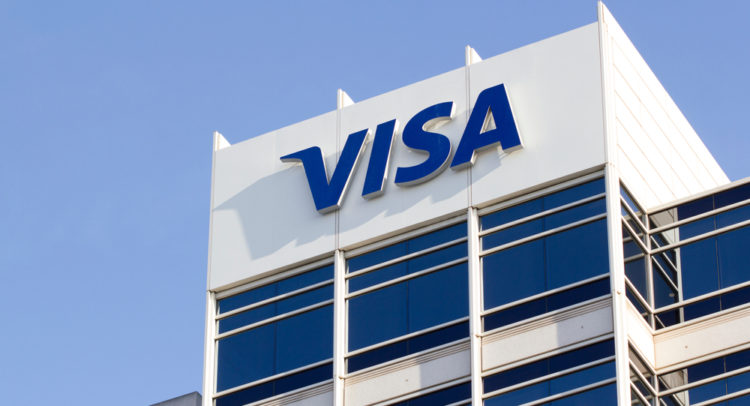When used safely and effectively, credit cards can facilitate some of the most useful debt for consumers, allowing the purchase of items based on the prospect of future income, as supported by modern theories of consumption.
Elevate Your Investing Strategy:
- Take advantage of TipRanks Premium at 50% off! Unlock powerful investing tools, advanced data, and expert analyst insights to help you invest with confidence.
Thanks to a near-monopoly on the industry, Visa (V) is in the perfect position to fulfill this ever-growing need, reaping impressive margins and substantial earnings growth in Q2 in spite of economic and geopolitical uncertainty, leading to the suspension of operations in Russia.
In fact, payments volume for the three months ended December 31, 2021, increased 20% over the year, and payments volume for the three months ended March 31, 2022, increased 17% over the year, both on a constant-currency basis.
International growth was also present in the quarter, as cross-border volume excluding transactions from Europe increased 38%.
Subsequently, total processed transactions in Q2 were $44.8 billion, an increase of 19% year-over-year.
In touting this performance, Chairman and CEO Alfred Kelly, Jr. stated, “We had a very strong quarter amidst the invasion of Ukraine and our decision to suspend operations in Russia, with GAAP EPS up 23% and non-GAAP EPS up 30%. The Omicron variant impacts were short-lived, and the global economic recovery that began in the middle of last year continued.”
Based on these results, he is confident that such performance is sustainable, explaining, “We expect continued growth driven by a robust travel recovery and through the enablement of traditional and newer ways to pay globally.”
Visa facilitates transactions between consumers, merchants, government entities, and financial institutions in over 200 countries and territories. With a mission to connect the world through secure and reliable transactions, Visa works toward empowering all individuals to partake in economic activities while creating the foundation for the future of money movement.
I’m bullish on Visa.
Strong Fundamentals
Visa’s increased volume from Payments certainly contributes to its fundamentals, creating enormous margins. To begin, gross, operating, and net margins are currently 97%, 67.6%, and 51.1%, respectively.
Similarly, Visa also enjoys a return on equity of 40% and a return on assets of 17%.
Further supporting this successful management of capital is the company’s positive economic profit of 11%, or the difference between the return on invested capital and the weighted average cost of capital, which has been increasing over the last several years.
The combination of such factors justifies Visa’s earnings growth in Q2, with net revenues of $7.2 billion, increasing 25% year-over-year. Moreover, GAAP net income was $3.6 billion or $1.70 per share, increases of 21% and 23%, respectively, over the prior year’s results.
Over the past three years, both revenue and EBITDA have grown at a 5.4% CAGR; the company was also profitable in all 10 of the previous years.
With such favorable results, Visa has been able to increase shareholder value through share repurchases and dividends, thanks in part to $3.22 billion of free cash flow generated in Q2. In doing so, $2.9 billion of common stock was repurchased in Q2, while $802 million was returned to shareholders in the form of dividends.
This is not out of the ordinary for Visa, however, as dividends have grown a considerable 15.1% CAGR over the last three years, which is certainly attractive for shareholders.
Looking toward the future, although the suspension of operations in Russia is expected to reduce second-half revenues by about 4%, third-quarter net revenues are expected to grow in the upper end of the mid-teens range in constant dollars, with domestic volume growth trends expected to be sustained. As such, full-year net revenue growth in constant dollars in the high-teens-to-20% range is expected.
An Entrenched Player Resulting from Wide Moats
There are several sustainable competitive advantages that can be identified within Visa that facilitate its strong performance and dominating market share of 54% in terms of purchase volume. They create near-monopolies, as competitors such as Mastercard (MA), American Express (AXP), and Discover Financial Services (DFS) possess mere market shares of 22.94%, 18.99%, and 4.08%, respectively (as of the year ended December 31, 2020).
To begin, Visa has established economies of scale and networking as the service becomes increasingly useful as more consumers use it and more businesses accept the service. Such a widespread network illustrates Metcalfe’s Law, which states that the value of a network is proportional to the square of its users, essentially enabling exponential growth.
Furthermore, there are several barriers to entry due to Visa’s secured customer base, brand, and regulations. If new competitors attempted to enter the industry, it would be extremely difficult to establish anywhere near the number of relationships Visa has secured with both consumers and merchants.
Even if achieved, it would require innovative services beyond that of Visa to convince customers to switch from a trusted and recognized brand.
Finally, Visa’s innovative potential was recently enhanced through the acquisition of Tink, an open banking platform allowing fintechs, merchants, and financial institutions to create financial products and services and move money, a perfect example of vertical integration.
The company is already integrated with over 3,400 banks and financial institutions across Europe, which will foster the already-present growth in this region.
The combination of these aspects in the business certainly creates a positive outlook toward the future.
Wall Street’s Take
Wall Street seems to concur with this outlook, as Visa has a Strong Buy rating based on 14 Buys, two Holds, and zero Sells. The average Visa price target of $267.81 suggests 25.8% upside potential, with a high price target of $310 and a low target of $235.

Conclusion
Whatever the macroeconomic conditions may be, consumers still need to spend money and require transactions that are majorly facilitated by credit cards to survive, as evident in the fact that consumer spending comprises approximately two-thirds of U.S. GDP.
Visa has placed itself in the perfect position and consequently surrounded itself with economic moats to operate efficiently and effectively, not only being convenient and creating opportunities to spend for consumers and merchants but leading to substantial growth and attractive shareholder value.
Read full Disclosure
















